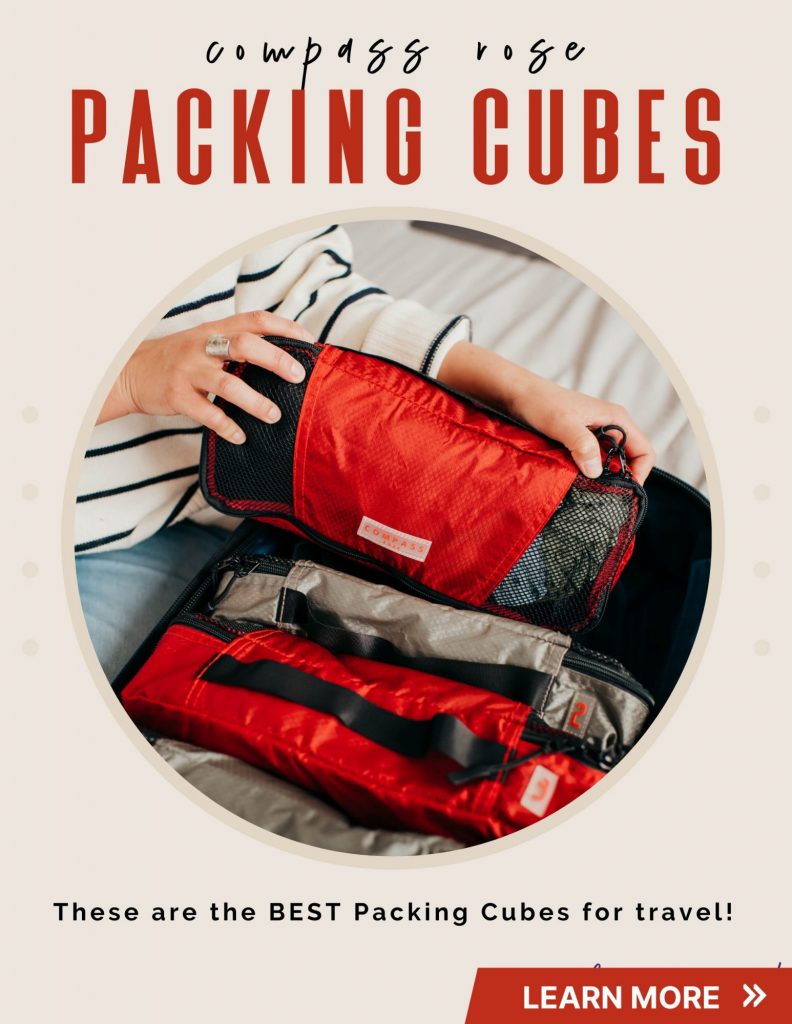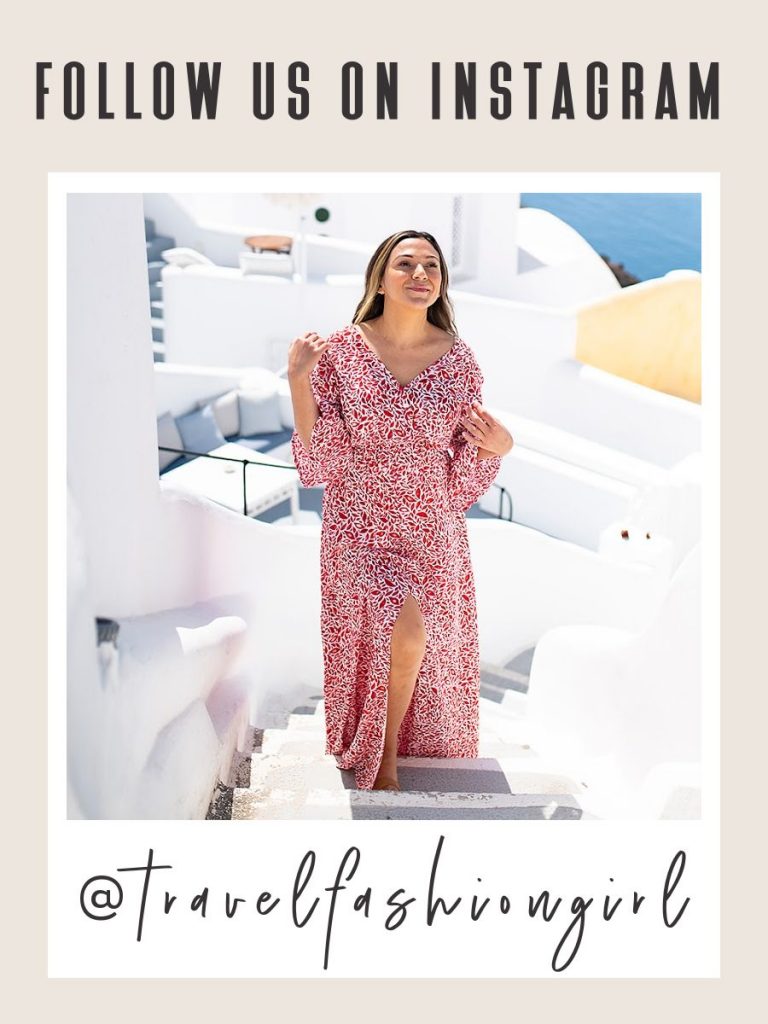
For this sample packing list for backpacking Europe, we’ve planned an itinerary for you that includes: Rome, Paris, Zurich, Amsterdam, Barcelona, Budapest, Prague, Berlin, and London. You can use these guidelines whether you’re backpacking Europe or on vacation.
Use this page for inspiration for a multi-stop trip and just add or replace your destinations. You can find tips for individual countries here!
This is a five part series. You can find the other seasonal packing list by clicking the thumbnails below and you’ll find the introductory guide here. Note: even if you’re NOT backpacking Europe, these tips are still relevant to any trip.
Read PART ONE of this series and visit each seasonal packing list for more tips:
SPRING | SUMMER | AUTUMN | WINTER
Packing List for Backpacking Europe: Autumn
While the weather varies from city to city, we’ve put together visuals that will help you determine the best autumn packing list for backpacking Europe. Autumn across Europe varies in temperature, but is undoubtedly cooler than the summer months and often sees high levels of rainfall.
Always check the weather forecast for each destination before your trip. Once you’ve researched the weather, you can focus on creating a travel capsule wardrobe, which should easily fit in your backpack with the help of packing cubes to compress your clothing.
Start by reading these general tips on packing for autumn travel:
- How to Pack for Trips with Mixed Weather
- How to Layer Clothes
- Use a Summer Dress to Pack Light in Fall
- Best Shoes for Traveling in Spring and Fall
If you need tips on creating a packing list for backpacking Europe during another time of year, please read the rest of this series.
Europe Clothing Style
Fashion in Europe is the same as other parts of the world. There are a variety of attire style preferences to reflect the tastes of different personalities. Don’t forget, Europe is a diverse region in terms of weather and style.
With the popularity of athleisure, over the years fashion across Europe, has become more “casual”, not to be confused with gym clothing.
However, casual or any other clothing in Europe generally tends to differ from some countries in the sense that people wear items that are fitted to their bodies. A tailored look is the true secret to the European everyday fashion observed by visitors.
As with most destinations, practical sense applies. Leave the beachwear for the beach because it doesn’t translate well to streetwear in a city. Unless you’re actually headed to the gym, you may want to consider not wearing gym attire.
While it’s not uncommon to wonder what do Europeans wear, it’s also important to remember that the best clothing to pack on any trip is what makes you feel most comfortable, both physically and emotionally because confidence is key to style everywhere around the globe.
Sample Packing List for Backpacking Europe in Autumn

Tee | Shirt | Long Sleeve T-Shirt | Button Up | Shirtdress | Chinos | Jeans 1 | Jeans 2 | Raincoat | Jacket | Hoodie | Cardigan | Loafer | Boots | Scarf | Backpack
2 Dresses (or Skirts)
Dresses are extremely versatile for travel, which is why we always add them to our packing list for backpacking Europe. Read our ultimate guide to dresses for travel!
Black is great for the autumn months and will allow you to easily mix and match with colorful footwear, cardigans, and jewelry. In addition, black will attract sunshine and provide you with added warmth.
On cooler days, the dress can be worn with a cardigan or jacket. Read this to learn what to wear on a rainy day when traveling. A popular way to wear dresses and skirts in Europe is to pair them with tights like this.
Alternately, pack a skirt that you can dress up if needed. Sweater knit dresses (that are not thick) are a great option!
3 Bottoms
Slim fit jeans offer a modern, contemporary style and look great teamed with ankle booties.Black is figure flattering, forgiving with dirt, and the best base to mix and match, allowing you to create a number of different looks. In general, dark denim such as a dark blue is recommended over light denim. Pack an extra set of trousers or pants like these.
Leggings are comfortable with their stretchy waistband and fabric and can be paired with virtually anything. Black is the best color to use as your base.
Leggings are an essential for your packing list for backpacking Europe in fall or any time of year because you can layer then under your jeans, skirts, or dresses. Just don’t wear them as pants! Check out the best leggings for women who travel.
Faux leather leggings are comfortable and provide great flexibility. Faux leather adds edge and sophistication to a look; it’s a great item for fashion capitals.
5 Tops
Plan to layer your clothing for the weather. Even in early autumn, cold weather can still be expected in some parts of Europe. However, you have to check the weather forecast in advance (weather.com) in order to make the best clothing choices.
In general, it’s advisable to pack a selection of varying length tops when backpacking in Europe in fall. Avoid t-shirts (unless they’re a nice quality like these) and opt for dressier tops instead.
One short sleeve top could work as either a base for your outfits or to be worn alone on warmer days. You can team them with any bottom or use them to layer for the cooler days. This will depend on how long you want to make your packing list for backpacking Europe.
Bring three long sleeve tops in varying thicknesses and knit fabrics for cold days. If it gets really cold, you should be able to layer these together if needed.
Make sure to bring at least one dressy top. The design of this top will act as a focal piece for your wardrobe. The higher-quality material will ensure that you have a dressier option if you need it.
2-3 Outerwear Pieces
Bring two-three pieces you can wear together when the temperatures drop. To save space, pack only one jacket to keep you warm and dry. If the majority of your clothing is in neutral colors, choose a colorful jacket and if your clothing is colorful choose a neutral color like these.
A v-neck cardigan would be comfortable and appropriate item to wear alone or layered when you need extra warmth. Alternatively, you can bring a sweater to wear under your jacket.
While not suitable for the snow or temperatures under 45F, (faux) leather jackets are great for travel as they’re waterproof, durable, and timeless. Avoid outdoor waterproof jackets if visiting major cities and choose a stylish option like one of these.
Wear your leather jacket on warmer days instead of a heavy coat, or underneath a coat for the coldest days. Perfect for backpacking in Europe like this stylish traveler!
The cooler seasons see the need for jackets and coats that are thicker to keep you warm during your journey. Opt for a down jacket that can keep you warm and pack light, too!
Remember, layering is key when backpacking through Europe any time of year, but especially in colder months. Ideally, you should be able to wear two pieces of outerwear together for maximum warmth.
Read this post to learn how to layer and stay warm in cold weather.
2-3 Shoes
It’s essential to have appropriate footwear when backpacking in Europe. You need shoes that are comfortable for walking for long periods, that are durable, waterproof, and stylish. Your footwear depends on your planned activities and personal preference.
One unexpected issue that many travelers discover once they get to Europe are the cobblestone streets.
While great to look at, stone streets aren’t always the easiest to walk on and can make for sore feet even if you don’t normally have discomfort. Depending on the city, these streets can also be hilly, slippery when wet, and uneven.
Popular shoe options to add to your packing list for backpacking Europe include (click each item below for suggested styles):
- Ankle Boots for spring and autumn
- Ballet Flats to dress up or for warm weather
- Waterproof Boots for rain and snow
- Comfortable Sightseeing shoes for year round visits
- Cute Comfortable Summer Sandals
Read this article on how to choose the best walking shoes for Europe.
Ankle boots are the preferred shoe for your packing list for backpacking Europe in fall. Find out why. They will keep your feet warm and dry during your travels. Choose (faux) leather for durability and comfort. They’re good for the rain, too!
Closed, flat shoes give your foot added support. Slip-on sneakers or canvas espadrilles are comfortable for walking. They are also easy to get on and off and are practical for traveling and day-time excursions. These comfortable walking shoes are popular sightseeing shoes for Europe.
In addition, we all love to dress up, but avoid heels because they’ll leave you feeling uncomfortable. For dressier shoes, skip the heels and bring cute and comfortable ballet flats. Instead of stilettos, opt for wedges. Do include one pair of shoes and one outfit that can be worn for dining out or experiencing the local nightlife.
Follow these tips on how to choose shoes for travel. Remember, three pairs is the magic number!

Thermal Top | Bottoms | Sunglasses | Beanie | Umbrella | Scarf | Bag | Sunscreen
Extras and Accessories
Along with clothing, there are some extras and accessories to add to your packing list for backpacking Europe.
Tights: Add 2 pairs of tights to your packing list. Opt for one in sheer and the other in knit, which will give you added warmth. They’re perfect to layer under dresses, skirts, and pants, too!
Thermals: If you’re traveling in late Autumn, consider packing thermals – they’re the secret to packing light in cold weather!
Umbrella: Don’t be caught off-guard; carry a travel size umbrella inside your handbag in case you get caught in an unexpected rain shower.
Hat: Choose a knit option – it will add instant warmth on cold days and hide bad hair days!
Sunglasses: Make sure your eyes are protected with quality sunglasses with UV protection.
Scarf: Scarves are the perfect accessory for adding warmth and a touch of color and personality to an otherwise neutral outfit. Pick scarves in your preferred colors and patterns.
Purse: Choose a crossbody purse or cute purse backpack.
Sun protection: Sunblock, sunglasses, hat, lipcare, etc. (If you forget these items, you can buy them at your destination.)
For individual countries, please refer to the corresponding packing list for Europe including advice directly from locals found here: TFG’s Europe Packing Lists.
Weather for Europe in Autumn
This is a brief summary of the weather for the cities we’ve chosen for our itinerary: Rome, Paris, Zurich, Amsterdam, Barcelona, Budapest, Prague, Berlin, and London. Use this as a guideline as you go backpacking through Europe in autumn:
For the most accurate forecast during your exact travel dates, visit weather.com.
Rome
Rome has a Mediterranean climate with hot dry summers and mild, rainy winters. Summer is the most popular time to visit the city, which is situated on the west coast of Italy. Not only is the weather warm and sunny with relatively low rainfall, there are many cultural attractions and an energy about the city that makes it such a popular tourist destination.
Autumn is the wettest season of the year–mostly overcast–and sees a decrease in daylight hours. The average temperature ranges between 16-22ºC / 61-72°F.
Get more tips in the Italy Packing List.
Paris
Paris: the beautiful French city known for its culture, fine food and wine, haute couture, and all things fashion. When visiting this city, it’s important to pack clothing for fine dining and dressing up as well as comfortable clothes for walking and sightseeing.
Paris has a temperate oceanic climate with warm summers and cold winters. Rainfall is moderate and steady year-round; showers are not uncommon. The temperatures in the autumn reach cool highs of 15ºC / 59°F and lows around 8ºC / 46°F. The level of rainfall is generally the same in all seasons, but autumn often has a gray backdrop.
Get more tips in the Paris Packing List.
Zurich
The largest city in Switzerland contains picturesque countryside, breathtaking architecture, great cuisine, and cosmopolitan nightlife. With the beautiful Lake Zurich, forests, and the Alps just 30 kilometers to the north of the city, there are many reasons to want to visit.
Zurich experiences relatively mild climates and is characterized by its summer highs and a very cold winter. Autumn is a good time to visit; fall arrives early in the higher elevations and has the highest rainfall of the year, but downpours are usually short.
Get more tips in the Zurich Packing List.
Amsterdam
Amsterdam is known to be a particularly rainy city (Europe’s 4th rainiest). It’s charming, beautiful, and filled with cobblestoned streets, flowers, and canals.
Autumn sees the highest levels of rainfall of the year. The temperatures reflect average highs of 13ºC / 52°F and 4ºC / 39°F lows.
Get more tips in the Amsterdam Packing List.
Barcelona
Barcelona enjoys a Mediterranean climate of hot summers and mild winters. The city is beautiful and filled with museums and celebrated art. With its glorious beaches, sunshine, and constant celebrations and festivals, the infectious energy of the city will enchant you.
Autumn is warm and wet, but rainfall and sunshine lessen as the season comes to an end. You can expect an average high temperature of 21°C / 70°F and lows around 12°C / 54°F.
Get more tips in the Spain Packing List.
Budapest
The beautiful capital of Hungary is filled with historical legacy, museums, and impressive architecture that consists of baroque, neoclassical, and nouveau buildings. The city experiences a continental climate with moderate rainfall and temperatures that are cold enough to support a fixed period of snow each year.
The autumn season in Budapest is light and clear and is known locally as the “vénasszonyok nyara’’, or Indian summer. Average highs are between 16-18ºC / 61-64ºF and the sky is clear and sunny.
Get more tips in the Budapest Packing List.
Prague
The Czech capital is a bohemian-style city, rich with history and celebrated architecture. Prague’s climate is continental, with clearly defined seasons, hot rainy summers, and cold winters. Spring and autumn have unpredictable weather.
The weather can change quickly in autumn. While it can be warm, with temperatures in the mid-20s°C / mid-70s°F, they can also drop as the season progresses to around 3°C / 37°F with the possibility of snowfall.
Get more tips in the Prague Packing List.
Berlin
The German capital is a beautiful, vibrant city known for fashion, design, music, and art. The city experiences a temperate continental climate and receives all four seasons with warm summers, cold winters, and moderate rainfall.
High temperatures drop from 19 to 7°C / 66 to 44°F; however, the weather is unpredictable and becomes unpleasant towards the end of the season with only two hours of daylight and higher rainfall.
Get more tips in the Berlin Packing List.
London
One of the most visited and celebrated cities, London is rich with history, architecture, art, museums, and trendy cafes. London experiences a temperate maritime climate with four seasons and no extremes.
Autumn can experience pleasant temperatures, with highs of 19°C / 66°F. However, the end of the season begins with a decrease in temperature, and late autumn is statistically the wettest time.
Get more tips in the London Packing List.
Read PART ONE of this series and visit each seasonal packing list for more tips:
SPRING | SUMMER | AUTUMN | WINTER
Want more tips on creating a packing list for backpacking Europe year-round?
Click here to go back to the other Packing Lists for Backpacking Europe.
Additional Travel Resources for Europe:
- Backpack Vs Suitcase: Which is Right for My Trip to Europe?
- Ultimate Guide to The Best Travel Purse for Europe
- Money Belts and Anti-Theft Travel Accessories
- 10-Step Packing Guide for Europe
- What to Wear in Europe: Packing List for Every Destination
LIKED THIS POST? PIN THIS PIC TO SAVE IT!













